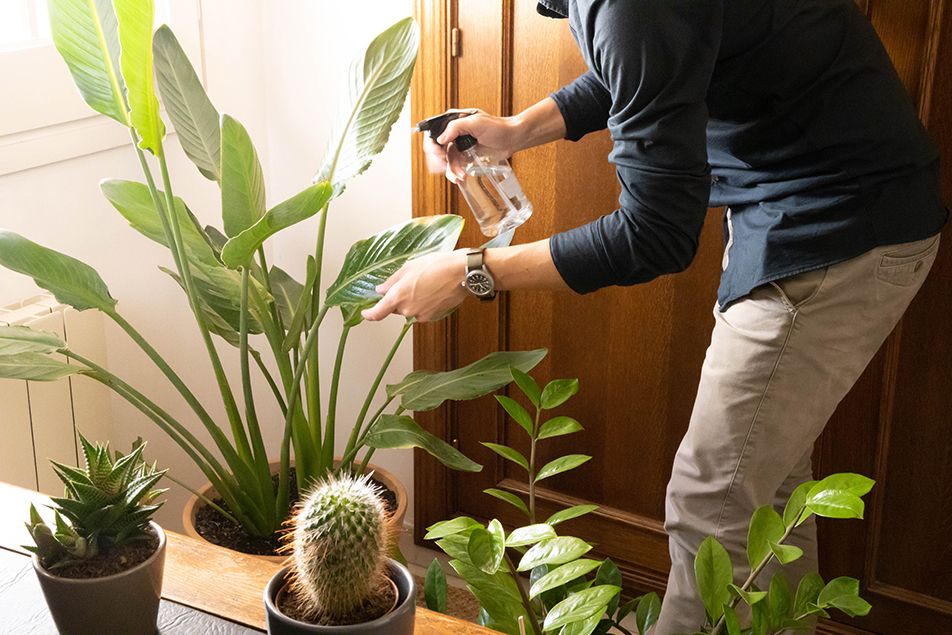
Indoor plants have been around for centuries. Many would agree that nothing brings more beauty and comfort into a room than these warm and inviting accents of greenery. To further explore this long-standing tradition, we asked Camille Schuelke, greenhouse farmer at the Parkview Community Greenhouse, to share the many health benefits that houseplants have to offer, how to care for them and where to find them.
Why should people consider having houseplants?
Indoor houseplants are great for several reasons. Not only are they excellent for their visual beauty, helping to spruce up the overall appearance of any space, but studies have shown that houseplants also bring a slew of health benefits to their owners.
What are the health benefits?
Many studies have shown that indoor plants offer both physical and psychological benefits, keeping us all healthier and happier. Houseplants can improve both your health and well-being by:
- improving concentration, creativity and productivity
- reducing stress and fatigue while also deterring illnesses like sore throats and colds
- helping clean the air in your home by absorbing toxins and producing oxygen while also increasing humidity
- boosting your mood and creating a therapeutic outlet by taking care of them
What are the best houseplants for beginners?
The top four houseplants that I would recommend for beginners and individuals wanting to get familiar with their green thumb include:
- Spider plants: These plants are tough, grow effortlessly and are extremely easy to maintain. Spider plants aren’t picky about water, light or temperature and look great in hanging baskets.
- Snake plants: These plants are exceptionally tough. They aren’t finicky when it comes to watering, and they can handle varying degrees of light. This plant is great for homes with lots of windows, but also dwellings and offices with less. They will thrive in either area.
- Peperomia: These plants have thick, waxy, ornamental leaves that come in a variety of colors. It is a forgiving plant, perfect for beginners, and looks beautiful on a desk or shelf. Peperomia tends to thrive in indirect sunlight and with a regular watering routine if the soil’s top is dry.
- Succulents or cacti: Desert plants like jade, aloe vera or desert cacti can have thick, fleshy leaves or spines while others have none. Fortunately, this class of houseplant grows slowly and can withstand rough conditions and neglect, which is perfect for the houseplant novice. With that said, these plants grow best in bright light, well-drained pots with little water.
Are there plants that shouldn’t be in your home?
While houseplants are a blessing and breathe life into any room, some could be harmful to individual households. For example, some plants could aggravate allergies or be harmful to your pets and young children. Jade, for example, is poisonous for pets and should be avoided if animals are in the home. On the other hand, Aloe vera is excellent for the skin and healing purposes, but it’s best not to ingest it. So, before bringing home a car full of houseplants, be sure to do your research to ensure you choose the plants that are the best fit for you and your family.
Are houseplants a good idea for people with busy schedules?
Yes, absolutely! The beginner plants I mentioned earlier would be great for busy individuals or families. They are robust, easy to take care of and will thrive in almost any condition, even if you forget to water them for even a week. Most of the time, they’ll bounce right back and be okay. So, don’t deprive yourself of the beauty and health benefits that houseplants can bring you. Instead, choose the plant that will fit into a fast-paced schedule and enjoy!
When should you water your houseplants?
Typically, it’s best to water your plants in the morning because they are active, awake and working with the sun. If you water them at night, all that water will sit there as they are asleep. It’s like when you eat a meal late at night and then go to bed. Your food sits in your stomach, waiting to be digested. With that said, watering your plants at night won’t hurt them. It’s just not as beneficial.
Does taking care of houseplants look different in the winter vs. summer months?
Yes! Believe it or not, most houseplants originated in tropical regions, making them well-suited to living indoors where the temperature never dips below freezing. This constant temperature allows your houseplants to thrive inside year-round. So, in the summer, their peak growing season, you’ll want to water your plants a little more because they’re active. Then, in winter, you’ll need to water them a little less because they’re not as active.
What can people do if their plants are drooping, yellowing or turning brown?
Every plant is different and thus requires specific care, but in general, if your plant’s leaves are drooping, it usually means they are thirsty and need water. If the leaves are yellowing, it means you’re overwatering your plant and should pull back on the amount or how often you are watering. If the leaves are turning brown, it could mean it’s starting to die, usually due to overwatering, in which case you should try only watering once a week to see if your plant bounces back.
Where are the best places to purchase houseplants?
Ideally, the best place to purchase your houseplants would be from your local greenhouse or florist. Some nurseries might have what you are looking for, but not all nurseries operate year-round. Utilizing local venues is great because you’re not only supporting local businesses, but you’re also going to have knowledgeable people there who can answer all your questions.
Final thoughts
Houseplants are so versatile. So, even if you are a beginner, don’t be afraid to experiment and play around with different varieties in your home. Remember to have fun with it. Happy gardening!



